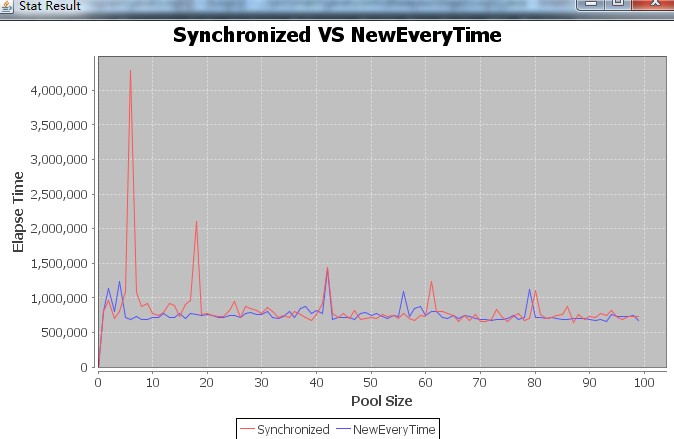在多线程环境下对字符串进行MD5,到底应该使用加锁来共享同一个MessageDigest呢?还是每次新创建一个,个人认为需要 根据程序运行的环境来分别对待。下边是从org.springframework.extensions.surf摘取的一段代码,实现了两种调用方式, 不过到底在何种情况下使用何种方式,目前还不是很清晰,希望通过测试能够得出结论。
- import java.security.MessageDigest;
- import java.security.NoSuchAlgorithmException;
- /**
- * The MD5 utility class computes the MD5 digest (aka: "hash") of a block
- * of data; an MD5 digest is a 32-char ASCII string.
- *
- * The synchronized/static function "Digest" is useful for situations where
- * lock contention in the application is not expected to be an issue.
- *
- * The unsynchronized/non-static method "digest" is useful in a
- * multi-threaded program that wanted to avoid locking by creating
- * an MD5 object for exclusive use by a single thread.
- *
- *
- *
- * EXAMPLE 1: Static usage
- *
- * import org.springframework.extensions.surf.util.MD5;
- * String x = MD5.Digest("hello".getBytes());
- *
- *
- * EXAMPLE 2: Per-thread non-static usage
- *
- * import org.springframework.extensions.surf.util.MD5;
- * MD5 md5 = new MD5();
- * ...
- * String x = md5.digest("hello".getBytes());
- *
- *
- * Email: diwayou@163.com
- * User: diwayou
- * Date: 13-4-15
- * Time: 下午11:18
- */
- public class MD5 {
- private static final byte[] ToHex_ =
- { '0','1','2','3','4','5','6','7',
- '8','9','a','b','c','d','e','f'
- };
- private MessageDigest md5_ = null;
- static private MessageDigest Md5_;
- static
- {
- try { Md5_ = MessageDigest.getInstance("MD5");} // MD5 is supported
- catch ( NoSuchAlgorithmException e ) {}; // safe to swallow
- };
- /**
- * Constructor for use with the unsynchronized/non-static method
- * "digest" method. Note that the "digest" function is not
- * thread-safe, so if you want to use it, every thread must create
- * its own MD5 instance. If you don't want to bother & are willing
- * to deal with the potential for lock contention, use the synchronized
- * static "Digest" function instead of creating an instance via this
- * constructor.
- */
- public MD5()
- {
- try { md5_ = MessageDigest.getInstance("MD5");} // MD5 is supported
- catch ( NoSuchAlgorithmException e ) {}; // safe to swallow
- }
- /**
- * Thread-safe static digest (hashing) function.
- *
- * If you want to avoid lock contention, create an instance of MD5
- * per-thead, anc call the unsynchronized method 'digest' instead.
- */
- public static synchronized String Digest(byte[] dataToHash)
- {
- Md5_.update(dataToHash, 0, dataToHash.length);
- return HexStringFromBytes( Md5_.digest() );
- }
- /**
- * Non-threadsafe MD5 digest (hashing) function
- */
- public String digest(byte[] dataToHash)
- {
- md5_.update(dataToHash, 0, dataToHash.length);
- return HexStringFromBytes( md5_.digest() );
- }
- private static String HexStringFromBytes(byte[] b)
- {
- byte [] hex_bytes = new byte[ b.length * 2 ];
- int i,j=0;
- for (i=0; i < b.length; i++)
- {
- hex_bytes[j] = ToHex_[ ( b[i] & 0x000000F0 ) >> 4 ] ;
- hex_bytes[j+1] = ToHex_[ b[i] & 0x0000000F ];
- j+=2;
- }
- return new String( hex_bytes );
- }
- }
下边是闲暇时写的一段测试代码,测试方式考虑因素还是比较少的,只考虑到了竞争线程的数量,代码如下:
- package com.diwayou.logq;
- import com.diwayou.logq.util.MD5;
- import org.jfree.chart.ChartFactory;
- import org.jfree.chart.ChartFrame;
- import org.jfree.chart.JFreeChart;
- import org.jfree.chart.plot.PlotOrientation;
- import org.jfree.data.xy.DefaultXYDataset;
- import org.jfree.data.xy.XYDataset;
- import java.io.UnsupportedEncodingException;
- import java.util.concurrent.ExecutorService;
- import java.util.concurrent.Executors;
- /**
- * Email: diwayou@163.com
- * User: diwayou
- * Date: 13-3-26
- * Time: 下午5:48
- */
- public class LogQ {
- public static void main(String[] args) throws UnsupportedEncodingException, InterruptedException {
- String s = "alibabagogogo";
- final byte[] message = s.getBytes("GBK");
- int coreNum = Runtime.getRuntime().availableProcessors();
- int scale = 100;
- System.out.println(String.format("Core size is %d", coreNum));
- int TEST_TIMES = 1;
- long startTime, endTime;
- DefaultXYDataset xyDataset = new DefaultXYDataset();
- double[][] elapse = new double[2][scale];
- for (int j = 0; j < scale; j++) {
- ExecutorService executorService = Executors.newFixedThreadPool(scale);
- startTime = System.nanoTime();
- for (int i = 0; i < TEST_TIMES; i++) {
- executorService.submit(new Runnable() {
- @Override
- public void run() {
- MD5.Digest(message);
- }
- });
- }
- executorService.shutdown();
- endTime = System.nanoTime();
- System.out.println(String.format("Pool size %d, elapse time %d", j, (endTime - startTime)));
- elapse[0][j] = j;
- if (j == 0) {
- elapse[1][j] = 0;
- } else {
- elapse[1][j] = endTime - startTime;
- }
- }
- xyDataset.addSeries("Synchronized", elapse);
- elapse = new double[2][scale];
- for (int j = 0; j < scale; j++) {
- ExecutorService executorService = Executors.newFixedThreadPool(scale);
- startTime = System.nanoTime();
- for (int i = 0; i < TEST_TIMES; i++) {
- executorService.submit(new Runnable() {
- @Override
- public void run() {
- MD5 md5 = new MD5();
- md5.digest(message);
- }
- });
- }
- executorService.shutdown();
- endTime = System.nanoTime();
- System.out.println(String.format("Pool size %d, elapse time %d", j, (endTime - startTime)));
- elapse[0][j] = j;
- if (j == 0) {
- elapse[1][j] = 0;
- } else {
- elapse[1][j] = endTime - startTime;
- }
- }
- xyDataset.addSeries("NewEveryTime", elapse);
- displayChart("Synchronized VS NewEveryTime", xyDataset);
- }
- private static void displayChart(String title, XYDataset dataset) {
- JFreeChart xyLineChart = ChartFactory.createXYLineChart(title, "Pool Size", "Elapse Time", dataset,
- PlotOrientation.VERTICAL, true, true, true);
- ChartFrame chartFrame = new ChartFrame("Stat Result", xyLineChart);
- chartFrame.pack();
- chartFrame.setVisible(true);
- }
- }
运行结果如下:
(1)第一次
Core size is 8
Pool size 0, elapse time 2012874
Pool size 1, elapse time 839776
..............
(2)第二次
Core size is 8
Pool size 0, elapse time 2256508
Pool size 1, elapse time 795155
Pool size 2, elapse time 968285
...................
结论:通过测试结果,可以看出每次都new一个新的并不比共享同一个MessageDigest慢,而且不需要锁,这样在服务器高并发的环境下,就不会出现共享锁性能瓶颈
的问题,这样可以减少由于共享锁出现的上下文切换,个人倾向于每次都new一个。
本人菜鸟一个,分析有误还请大家支出,随便批评,这样我才能进步。






















 158
158

 被折叠的 条评论
为什么被折叠?
被折叠的 条评论
为什么被折叠?








